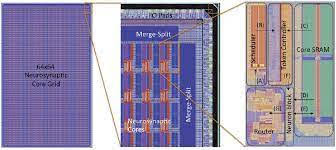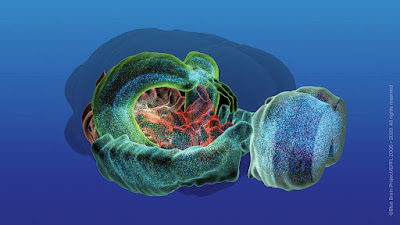Computational
neuroscience (CNS) is a branch of neuroscience that uses the notion of
computing to the study of the brain.
Eric Schwartz coined the phrase "computational
neuroscience" in 1985 to replace the words "neural modeling" and
"brain theory," which were previously used to describe different
forms of nervous system study.
The concept that nervous system effects may be perceived as
examples of computations, since state transitions can be explained as relations
between abstract attributes, is at the heart of CNS.
In other words, explanations of effects in neurological
systems are descriptions of information changed, stored, and represented,
rather than casual descriptions of interaction of physically distinct elements.
As a result, CNS aims to develop computational models to
better understand how the nervous system works in terms of the information
processing characteristics of the brain's parts.
Constructing a model of how interacting neurons might build
basic components of cognition is one example.
A brain map, on the other hand, does not disclose the
nervous system's computing process, but it may be utilized as a restriction for
theoretical models.
Information sharing, for example, has costs in terms of
physical connections between communicating areas, in that locations that make
connections often (in cases of high bandwidth and low latency) would be
clustered together.
The description of neural systems as carry-on computations
is central to computational neuroscience, and it contradicts the claim that
computational constructs are exclusive to the explanatory framework of
psychology; that is, human cognitive capacities can be constructed and
confirmed independently of how they are implemented in the nervous system.
For example, when it became clear in 1973 that cognitive
processes could not be understood by analyzing the results of one-dimensional
questions/scenarios, a popular approach in cognitive psychology at the time,
Allen Newell argued that only synthesis with computer simulation could reveal
the complex interactions of the proposed component's mechanism and whether the
proposed component's mechanism was correct.
David Marr (1945–1980) proposed the first computational
neuroscience framework.
This framework tries to give a conceptual starting point for
thinking about levels in the context of computing by nervous structure.
It reflects the three-level structure utilized in computer
science (abstract issue analysis, algorithm, and physical implementation).
The model, however, has drawbacks since it is made up of
three poorly linked layers and uses a rigid top-down approach that ignores all
neurobiological facts as instances at the implementation level.
As a result, certain events are thought to be explicable on
just one or two levels.
As a result, the Marr levels framework does not correspond
to the levels of nervous system structure (molecules, synapses, neurons,
nuclei, circuits, networks layers, maps, and systems), nor does it explain
nervous system emergent type features.
Computational neuroscience takes a bottom-up approach,
beginning with neurons and illustrating how computational functions and their
implementations with neurons result in dynamic interactions between neurons.
Models of connectivity and dynamics, decoding models, and
representational models are the three kinds of models that try to get
computational understanding from brain-activity data.
The correlation matrix, which displays pairwise functional
connectivity between places and establishes the features of related areas, is
used in connection models.
Because they are generative models, they can generate data
at the level of the measurements and are models of brain dynamics, analyses of
effective connectivity and large-scale brain dynamics go beyond generic
statistical models that are linear models used in action and information-based
brain mapping.
The goal of the decoding models is to figure out what
information is stored in each brain area.
When an area is designated as a "knowledge
representing" one, its data becomes a functional entity that informs
regions that receive these signals about the content.
In the simplest scenario, decoding identifies which of the
two stimuli elicited a recorded response pattern.
The representation's content might be the sensory stimulus's
identity, a stimulus feature (such as orientation), or an abstract variable
required for a cognitive operation or action.
Decoding and multivariate pattern analysis were utilized to
determine the components that must be included in the brain computational
model.
Decoding, on the other hand, does not provide models for
brain computing; rather, it discloses some elements without requiring brain
calculation.
Because they strive to characterize areas' reactions to
arbitrary stimuli, representation models go beyond decoding.
Encoding models, pattern component models, and
representational similarity analysis are three forms of representational model
analysis that have been presented.
All three studies are based on multivariate descriptions of
the experimental circumstances and test assumptions about representational
space.
In encoding models, the activity profile of each voxel
across stimuli is predicted as a linear combination of the model's properties.
The distribution of the activity profiles that define the
representational space is treated as a multivariate normal distribution in
pattern component models.
The representational space is defined by the representational
dissimilarities of the activity patterns evoked by the stimuli in
representational similarity analysis.
The qualities that indicate how the information processing
cognitive function could operate are not tested in the brain models.
Task performance models are used to describe cognitive
processes in terms of algorithms.
These models are put to the test using experimental data
and, in certain cases, data from brain activity.
Neural network models and cognitive models are the two basic
types of models.
Models of neural networks are created using varying degrees
of biological information, ranging from neurons to maps.
Multiple steps of linear-nonlinear signal modification are
supported by neural networks, which embody the parallel distributed processing
paradigm.
To enhance job performance, models often incorporate
millions of parameters (connection weights).
Simple models will not be able to describe complex cognitive
processes, hence a high number of parameters is required.
The implementations of deep convolutional neural network
models have been used to predict brain representations of new pictures in the
ventral visual stream of primates.
The representations in the first few layers of neural
networks are comparable to those in the early visual cortex.
Higher layers are similar to the inferior temporal cortical
representation in that they both allow for the decoding of object location,
size, and posture, as well as the object's categorization.
Various research have shown that deep convolutional neural
networks' internal representations provide the best current models of visual
picture representations in the inferior temporal cortex in humans and animals.
When a wide number of models were compared, those that were
optimized for object categorization described the cortical representation the
best.
Cognitive models are artificial intelligence applications in
computational neuroscience that target information processing that do not
include any neurological components (neurons, axons, etc.).
Production systems, reinforcement learning, and Bayesian
cognitive models are the three kinds of models.
They use logic and predicates, and they work with symbols
rather than signals.
There are various advantages of employing artificial
intelligence in computational neuroscience research.
- First, although a vast quantity of information on the brain
has accumulated through time, the true knowledge of how the brain functions
remains unknown.
- Second, there are embedded effects created by networks of
neurons, but how these networks of neurons operate is yet unknown.
- Third, although the brain has been crudely mapped, as has
understanding of what distinct brain areas (mostly sensory and motor functions)
perform, a precise map is still lacking.
Furthermore, some of the information gathered via
experiments or observations may be useless; the link between synaptic learning
principles and computing is mostly unclear.
The models of a production system are the first models for
explaining reasoning and problem resolution.
A "production" is a cognitive activity that occurs
as a consequence of the "if-then" rule, in which "if"
defines the set of circumstances under which the range of productions
("then" clause) may be carried out.
When the prerequisites for numerous rules are satisfied, the
model uses a conflict resolution algorithm to choose the best production.
The production models provide a sequence of predictions that
seem like a conscious stream of brain activity.
The same approach is now being used to predict the regional
mean fMRI (functional Magnetic Resonance Imaging) activation time in new
applications.
Reinforcement models are used in a variety of areas to
simulate the accomplishment of optimum decision-making.
The implementation in neurobiological systems is a basal
ganglia in neurobiochemical systems.
The agent might learn a "value function" that
links each state to the predicted total reward.
The agent may pick the most promising action if it can
forecast which state each action will lead to and understands the values of
those states.
The agent could additionally pick up a "policy"
that links each state to promised actions.
Exploitation (which provides immediate gratification) and
exploration must be balanced (which benefits learning and brings long-term
reward).
The Bayesian models show what the brain should really
calculate in order to perform at its best.
These models enable inductive inference, which is beyond the
capability of neural network models and requires previous knowledge.
The models have been used to explain cognitive biases as the
result of past beliefs, as well as to comprehend fundamental sensory and motor
processes.
The representation of the probability distribution of
neurons, for example, has been investigated theoretically using Bayesian models
and compared to actual evidence.
These practices illustrate that connecting Bayesian
inference to real brain implementation is still difficult since the brain
"cuts corners" in trying to be efficient, therefore approximations
may explain departures from statistical optimality.
The concept of a brain doing computations is central to
computational neuroscience, so researchers are using modeling and analysis of
information processing properties of nervous system elements to try to figure
out how complex brain functions work.
~ Jai Krishna Ponnappan
You may also want to read more about Artificial Intelligence here.
See also:
Bayesian Inference; Cognitive Computing.
Further Reading
Kaplan, David M. 2011. “Explanation and Description in Computational Neuroscience.” Synthese 183, no. 3: 339–73.
Kriegeskorte, Nikolaus, and Pamela K. Douglas. 2018. “Cognitive Computational Neuroscience.” Nature Neuroscience 21, no. 9: 1148–60.
Schwartz, Eric L., ed. 1993. Computational Neuroscience. Cambridge, MA: Massachusetts Institute of Technology.
Trappenberg, Thomas. 2009. Fundamentals of Computational Neuroscience. New York: Oxford University Press.



















